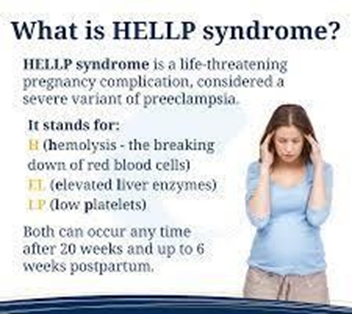The labor of a pregnant teenager with preeclampsia is going to be induced. Before initiating the Oxytocin infusion, the nurse reviews the woman's latest laboratory test findings, which reveal a platelet count of 80,000, an elevated aspartate transaminase (AST) level (250 U/L), and falling hemoglobin from 14 to 11 g/dl. The nurse notifies the physician because the laboratory results are indicative of
Select one:
Idiopathic thrombocytopenia.
Disseminated intravascular coagulation (DIC).
HELLP syndrome.
Eclampsia.
Eclampsia.
The Correct Answer is C
a. Idiopathic thrombocytopenia is a condition characterized by a low platelet count without an identifiable cause, which is not the case in this scenario.
b. Disseminated intravascular coagulation (DIC) is a condition characterized by widespread activation of the clotting system, which is not the case in this scenario.
c. HELLP syndrome is a serious complication of preeclampsia characterized by hemolysis, elevated liver enzymes, and low platelet count.
d. Eclampsia is a severe complication of preeclampsia characterized by seizures, which is not the case in this scenario.

Nursing Test Bank
Naxlex Comprehensive Predictor Exams
Related Questions
Correct Answer is C
Explanation
a. A positive CST indicates late decelerations that persist in more than 50% of the contractions, which is not the case in this scenario.
b. A negative CST indicates the absence of late decelerations, which is not the case in this scenario.
c. A satisfactory CST indicates that there are no late decelerations, and the test is considered normal.
d. Reactive is not a term used to interpret a CST.
Correct Answer is C
Explanation
a. This is a correct statement. Fertilization takes place in the outer third of the fallopian tube.
b. This is a correct statement.
c. Implantation usually occurs about 6 to 10 days after fertilization, which means it happens between 2 and 3 weeks after conception.
d. This is a correct statement.
Whether you are a student looking to ace your exams or a practicing nurse seeking to enhance your expertise , our nursing education contents will empower you with the confidence and competence to make a difference in the lives of patients and become a respected leader in the healthcare field.
Visit Naxlex, invest in your future and unlock endless possibilities with our unparalleled nursing education contents today
Report Wrong Answer on the Current Question
Do you disagree with the answer? If yes, what is your expected answer? Explain.
Kindly be descriptive with the issue you are facing.
